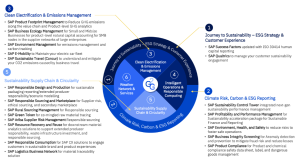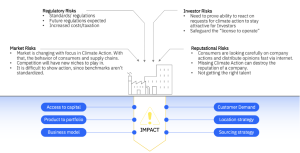Environmental, Social, and Governance Reporting Using SAP Profitability and Performance Management
Author: Nuno Guimarães, Head of IBM TruQua EMEA
Environmental, Social, and Governance Reporting Using SAP Profitability and Performance Management
As sustainability initiatives continue to play a prominent role in many organizational strategies, so does the need to ensure these initiatives are integrated with financial aims. Beyond targets themselves, a value-informed consumer environment is seeing more businesses talking about “purpose” in their corporate statements as well as setting out visions that integrate financial aims with social and environmental goals.
Environmental, Social, and Governance (ESG) reporting enables organizations to identify potential risks within their sustainability planning.
On the opposite end, and according to Morgan Stanley Capital International (MSCI), companies with higher ESG scores tend to operate more efficiently and experience lower costs of capital compared to companies with poor ESG scores.
Transitioning to more sustainable processes, however, is not trivial or cheap. Business controllers need to carefully assess the impact of the “green revolution” on staff, processes, and finance across the enterprise. Many CFOs are wondering how much it will cost and what are the risks/rewards associated with it. There is a strong link between finance and sustainability planning.
At a time where most companies started (or intend to start) the journey, the proliferation of sustainability accounting standards is making progress measurement and reporting a complex task, especially for multinationals subject to different standards and regulations by geography.
More Sophisticated ESG Reporting
Global Reporting Initiative (GRI) , Sustainability Accounting Standards Board (SASB), and the Taskforce on Climate-Related Financial Disclosures (TCDF) are just some of top emerging reporting needs.
These complexities have prompted companies to explore more comprehensive reporting solutions to help streamline the reporting process and provide customers, investors, and regulators the transparency, auditability, and consistency they need. This is critical to build trust with all customers and business partners.
In most companies and despite efforts, reporting of ESG factors suffers from considerable shortcomings that undermine its usefulness, resulting in the low trust scores. Evolving regulation, fast paced business changes, siloing of data, lack of automation and comprehensive and quantifiably useful output are all issues that impact clear reporting.
While ESG reporting is challenging, SAP is no stranger to complex reporting. SAP is the global ERP leader with emphasis on finance and reporting, where, like in ESG, different standards, methodologies, and regulations apply.
Building upon this experience and recognizing the necessity to act, SAP has already invested heavily in creating solutions for sustainability reporting that can be leveraged by organizations to support all areas of sustainability reporting and planning.

Figure 2 – SAP’s Solutions for Sustainability Reporting and Planning
When it comes to Sustainability Reporting, there are two main solutions to consider.
- SAP Sustainability Control Tower: A recently launched SAP comprehensive solution that contains, amongst other topics, predefined content for reporting World Economic Forum metrics. SAP Sustainability Control Tower is based on SAP Business Technology Platform (BTP) and leverages SAP Analytics Cloud, SAP Data Warehouse Cloud and (optionally), SAP Profitability and Performance Management.
- SAP Profitability and Performance Management (PaPM): A gross selling solution in the market for the last 5 years that contains ESG reporting content such as:
SAP Profitability and Performance Management was built originally to handle granular profitability modelling and reporting. Technically, it is a very similar exercise to sustainability reporting if we swap currency amounts by carbon emissions: it needs to gather data from the transactional systems (especially general ledger), operational systems, market data and then perform complex methodologies to output the reporting.
SAP PaPM can concentrate finance and sustainability data, allowing companies to make correlations and more informed decisions that consider both financial and ESG key performance indicators.
Conclusion
Understanding that there is a strong link between profitability and sustainability, we believe clients should have perspectives that link one to another.
For early adopters (at the time this article was written), SAP Sustainability Control Tower is a recent solution with a great roadmap, and it contains SAP Profitability and Performance Management (PaPM) as an optional component.
For more conservative customers, we recommend leveraging PaPM’s comprehensive capabilities to start sustainability reporting as it has more flexibility and use cases beyond ESG that help the business case value.
As SAP Sustainability Control Tower develops, the step already done with SAP PaPM will be leveraged to accelerate the SAP Sustainability Control Tower implementation.
For more information on this topic, contact us today at truqua@us.ibm.com or simply fill out the form below.
About the Author

Nuno Guimarães, Head of IBM TruQua EMEA, has dedicated his career to helping the office of the CFO transition from compliance driven to strategy focused using modern technologies. With experience across EMEA, Latin America, and North America, Nuno has delivered finance and FP&A solutions for companies such as Google, Zurich Financial Group, Northern Trust, Allstate , Repsol, amongst others.






